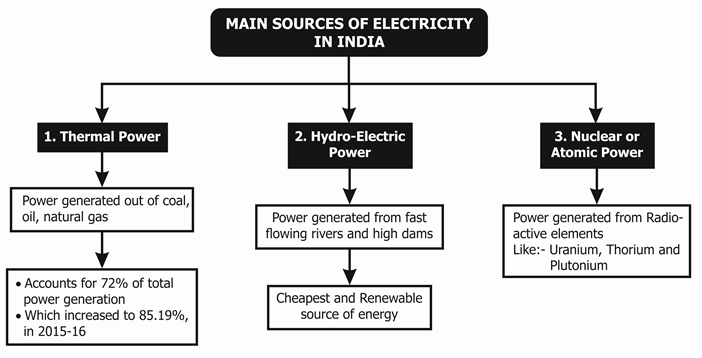Power is one of the basic components of infrastructure, that defines the country’s economic development and the quality of life of an individual. Power is the most visible form of energy, that is generally known as electricity. Out of all the power resources available for consumption in India, thermal sources counted 67 percent of power production capacity, 14 percent Hydel power, and 2 percent nuclear power.
Challenges of Power Sector in India
- Insufficient Electricity Generation- In India, the installed capacity to produce electricity is not enough to support an annual economic growth of 7 to 8 percent. Currently, India only adds 20,000 MW a year to generate power.
- Poor Management-The State Electricity Boards (SEBs) incurred losses of more than Rs.500 million because of improper transmission of electricity, wrong pricing, and other incompetence. Few scholars have come to the conclusion that the main reason for the losses is the circulation of power to farmers (they have to only pay minimum chargers or is free), electricity is stolen, that result in losses under the account of SEBs.
- Lack of Investments- When it comes to power and energy, the private sector do not play any part or there are any foreign investors. The public sector is almost having a monopoly in the power generation sector.
- Poor Infrastructure- Too many power cuts in various parts of the country and huge power tariff.
- Shortage of Raw Material- In India, the thermal power plant the main source of generating power is facing a high deficit of coal and raw materials supplies.
| You Might Also Like To Read: |
Sources of Electricity in India

| Also, Explore: |
Solved Questions:
| Briefly explain the three main sources of electricity (power) in India. | |
| Answer: Following are the three main sources of electricity in India: | |
| (1) Thermal Power |
|
| (2) Hydro-electric Power |
|
| (3) Nuclear or Atomic Power |
|
| Problems faced by the power sector in India | |
| (1)Insufficient Electricity Generation |
|
| (2)Underutilization Of Capacity |
|
| (3)Poor Performance Of State Electricity Boards(Seb’s) |
|
| (4) Limited Role Of Private And Foreign Entrepreneurs |
|
You might also want to know: Economic system in India
Short Questions:
| Q.1- What Are The Three Basic Source Of Generating Power? (NCERT) |
| Answer: |
| The three main sources of generating power are:
(i) Thermal Power, (ii) Hydro-electric Power, and (iii) Nuclear of Atomic Power. |
| Q.2- What Do You Mean By Transmission And Distribution Loss? (NCERT) |
| Answer: |
| It includes losses in transmission between sources of supply and the points of distribution and in the distribution to consumers, including pilferage. |
| Q.3- Mention The Emerging Challenges Of Power Generation In India? (NCERT) |
| Answer: |
| Following are the major challenges in power generation:
(i) Inadequate generation of electricity, (ii) Utilization of Less capacity, and (iii) Losses of electricity board etc. |
| Q.4- What Do You Mean By Plant Load Factor? |
| Answer: |
| PLF shows the level of production of power generation plant which can be utilized. |
| Important Topics in Economics: |
For more data on Economics Class 11 Syllabus, Commerce notifications and sample papers for class 11 Commerce, stay tuned to BYJU’S.
Comments